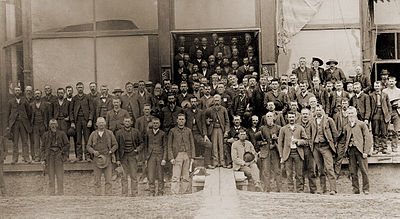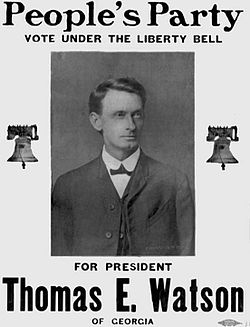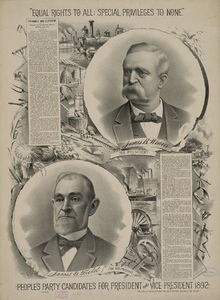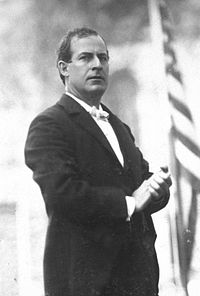- People's Party (United States)
-
- This is about the American political party commonly known as the "Populists" which existed from 1892 to 1908. For other American and worldwide parties using the term populists see Populist Party. For the American party with the same name which was active in the 1970s see People's Party (United States, 1971). For the party existing in the Utah Territory from 1870-1891 see People's Party (Utah).
People's Party 
Founded 1891 Dissolved 1908 Ideology Populism, bimetallism Political position Left-wing International affiliation None Official colors Blue Politics of the United States
Political parties
ElectionsThe People's Party, also known as the "Populists", was a short-lived political party in the United States established in 1891. It was most important in 1892-96, then rapidly faded away. Based among poor, white cotton farmers in the South (especially North Carolina, Alabama, and Texas) and hard-pressed wheat farmers in the plains states (especially Kansas and Nebraska), it represented a radical crusading form of agrarianism and hostility to banks, railroads, and elites generally. It sometimes formed coalitions with labor unions, and in 1896 endorsed the Democratic presidential nominee, William Jennings Bryan. The terms "populist" and "populism" are commonly used for anti-elitist appeals in opposition to established interests and mainstream parties.
Contents
History
Formation
 People's Party candidate nominating convention held at Columbus, Nebraska, July 15, 1890.
People's Party candidate nominating convention held at Columbus, Nebraska, July 15, 1890.
A People's Party grew out of agrarian unrest in response to low agricultural prices in the South and the trans-Mississippi West.[1] The Farmers' Alliance, formed in Lampasas, TX in 1876, promoted collective economic action by farmers and achieved widespread popularity in the South and Great Plains. The Farmers' Alliance ultimately did not achieve its wider economic goals of collective economic action against brokers, railroads, and merchants, and many in the movement agitated for changes in national policy. By the late 1880s, the Alliance had developed a political agenda that called for regulation and reform in national politics, most notably an opposition to the gold standard to counter the high deflation in agricultural prices in relation to other goods such as farm implements.
In December 1888 the National Agricultural Wheel and the Southern Farmer’s Alliance met at Meridian, Mississippi. In that meeting they decided to consolidate the two parties pending ratification. This consolidation gave the organization a new name, the Farmers and Laborers’ Union of America, and by 1889 the merger had been ratified, although there were conflicts between “conservative” Alliance men and “political” Wheelers in Texas and Arkansas, which delayed the unification in these states until 1890 and 1891 respectively. The merger eventually united white Southern Alliance and Wheel members, but it would not include African American members of agricultural organizations.[2]
During their move towards consolidation in 1889, the leaders of both Southern Farmers’ Alliance and the Agricultural Wheel organizations contacted Terence V. Powderly, leader of the Knights of Labor. “This contact between leaders of the farmers’ movement and Powderly helped pave the way for a series of reform conferences held between December 1889 and July 1892 that resulted in the formation of the national People’s (or Populist) Party.”[3]
The drive to create a new political party out of the movement arose from the belief that the two major parties Democrats and Republicans were controlled by bankers, landowners and elites hostile to the needs of the small farmer. The movement reached its peak in 1892 when the party held a convention chaired by Frances Willard (leader of the WCTU and a friend of Powderly's)[4] in Omaha, Nebraska and nominated candidates for the national election.
The party's platform, commonly known as the Omaha Platform, called for the abolition of national banks, a graduated income tax, direct election of Senators, civil service reform, a working day of eight hours and Government control of all railroads, telegraphs, and telephones. In the 1892 Presidential election, James B. Weaver received 1,027,329 votes. Weaver carried four states (Colorado, Kansas, Idaho, and Nevada) and received electoral votes from Oregon and North Dakota as well.
The party flourished most among farmers in the Southwest and Great Plains, as well as making significant gains in the South, where they faced an uphill battle given the firmly entrenched monopoly of the Democratic Party. Success was often obtained through electoral fusion, with the Democrats outside the South, but with alliances with the Republicans in Southern states like Alabama, North Carolina, Tennessee, and Texas.[5] For example, in the elections of 1894, a coalition of Populists and Republicans led by Populist Marion Butler swept state and local offices in North Carolina, and the coalition would go on to elect Republican Daniel Lindsay Russell as Governor in 1896.[6]
Quite separate from the Populists were the Silverites in the western mining states, who demanded Free silver to solve the Panic of 1893.
The Populists followed the Prohibition Party in actively including women in their affairs. Some southern Populists, including Thomas E. Watson of Georgia, openly talked of the need for poor blacks and poor whites to set aside their racial differences in the name of shared economic self-interest. Regardless of these rhetoric appeals, however, racism did not evade the People's Party. Prominent Populist Party leaders such as Marion Butler, a United States Senator from North Carolina, at least partially demonstrated a dedication to the cause of white supremacy, and there appears to have been some support for this viewpoint among the rank-and-file of the party's membership.[7] After 1900 Watson himself became an outspoken white supremacist and became the party's presidential nominee in 1904 and 1908, winning 117,000 and 29,000 votes.
Presidential election of 1896
By 1896, the Democratic Party took up many of the People's Party's causes at the national level, and the party began to fade from national prominence. In that year's presidential election, the Democrats nominated William Jennings Bryan, who focused (as Populists rarely did) on the free silver issue as a solution to the economic depression and the maldistribution of power. One of the great orators of the day, Bryan generated enormous excitement among Democrats with his "Cross of Gold" speech, and appeared in the summer of 1896 to have a good chance of winning the election, if the Populists voted for him.
The Populists had the choice of endorsing Bryan or running their own candidate. After great infighting at their St. Louis convention they decided to endorse Bryan but with their own vice presidential nominee, Thomas E. Watson of Georgia. Watson was cautiously open to cooperation, but after the election would recant any hope he had in the possibility of cooperation as a viable tool.[8] Bryan's strength was based on the traditional Democratic vote (minus the middle class and the Germans); he swept the old Populist strongholds in the west and South, and added the silverite states in the west, but did poorly in the industrial heartland. He lost to Republican William McKinley by a margin of 600,000 votes, and lost again in a rematch in 1900 by a larger margin.[9]
Fading fortunes
The effects of fusion with the Democrats were disastrous to the Party in the South. The Populist/Republican alliance which had governed North Carolina fell apart in North Carolina, the only state in which it had any success. By 1898, the Democrats used a violently racist campaign to defeat the North Carolina Populists and GOP and in 1900 the Democrats ushered in disfranchisement.[10]
Populism never recovered from the failure of 1896. For example, Tennessee’s Populist Party was demoralized by a diminishing membership, and puzzled and split by the dilemma of whether to fight the state-level enemy (the Democrats) or the national foe (the Republicans and Wall Street). By 1900 the People’s Party of Tennessee was a shadow of what it once was[11]
In 1900, while many Populist voters supported Bryan again, the weakened party nominated a separate ticket of Wharton Barker and Ignatius L. Donnelly, and disbanded afterwards. Populist activists either retired from politics, joined a major party, or followed Eugene Debs into his new Socialist Party.
Reorganization
In 1904, the party was re-organized, and Thomas E. Watson was their nominee for president in 1904 and in 1908, after which the party disbanded again.
Historians look at Populism
Since the 1890s historians have vigorously debated the nature of Populism; most scholars have been liberals who admired the Populists for their attacks on banks and railroads. Some historians see a close link between the Populists of the 1890s and the progressives of 1900-1912, but most of the leading progressives (except Bryan himself) fiercely opposed Populism. Thus Theodore Roosevelt, George W. Norris, Robert LaFollette, William Allen White and Woodrow Wilson strongly opposed Populism. It is debated whether any Populist ideas made their way into the Democratic party during the New Deal era. The New Deal farm programs were designed by experts (like Henry Wallace) who had nothing to do with Populism.[12]
 People's Party campaign poster from 1904 touting the candidacy of Thomas E. Watson.
People's Party campaign poster from 1904 touting the candidacy of Thomas E. Watson.
Some historians see the populists as forward-looking liberal reformers. Others view them as reactionaries trying to recapture an idyllic and utopian past. For some they are radicals out to restructure American life, and for others they are economically hard-pressed agrarians seeking government relief. Much recent scholarship emphasizes Populism's debt to early American republicanism.[13] Clanton (1991) stresses that Populism was "the last significant expression of an old radical tradition that derived from Enlightenment sources that had been filtered through a political tradition that bore the distinct imprint of Jeffersonian, Jacksonian, and Lincolnian democracy." This tradition emphasized human rights over the cash nexus of the Gilded Age's dominant ideology.[14]
Frederick Jackson Turner and a succession of western historians depicted the Populist as responding to the closure of the frontier. Turner explained:
- The Farmers' Alliance and the Populist demand for government ownership of the railroad is a phase of the same effort of the pioneer farmer, on his latest frontier. The proposals have taken increasing proportions in each region of Western Advance. Taken as a whole, Populism is a manifestation of the old pioneer ideals of the native American, with the added element of increasing readiness to utilize the national government to effect its ends.[15]
The most influential Turner student of Populism was John D. Hicks, who emphasized economic pragmatism over ideals, presenting Populism as interest group politics, with have-nots demanding their fair share of America's wealth which was being leeched off by nonproductive speculators. Hicks emphasized the drought that ruined so many Kansas farmers, but also pointed to financial manipulations, deflation in prices caused by the gold standard, high interest rates, mortgage foreclosures, and high railroad rates. Corruption accounted for such outrages and Populists presented popular control of government as the solution, a point that later students of republicanism emphasized.[16]
In the 1930s C. Vann Woodward stressed the southern base, seeing the possibility of a black-and-white coalition of poor against the overbearing rich. Georgia politician Tom Watson served as Woodward's hero.[17] In the 1950s, however, scholars such as Richard Hofstadter portrayed the Populist movement as an irrational response of backward-looking farmers to the challenges of modernity. He discounted third party links to Progressivism and argued that Populists were provincial, conspiracy-minded, and had a tendency toward scapegoatism that manifested itself as nativism, anti-Semitism, anti-intellectualism, and Anglophobia. The antithesis of anti-modern Populism was modernizing Progressivism in this model, with such leading progressives as Theodore Roosevelt, Robert LaFollette, George Norris and Woodrow Wilson had been vehement enemies of Populism, though William Jennings Bryan did cooperate with them and accepted the Populist nomination in 1896.[18]
Michael Kazin's The Populist Persuasion (1995) argued that Populism reflected a rhetorical style that manifested itself in spokesmen like Father Charles Coughlin in the 1930s and Governor George Wallace in the 1960s.
Postel (2007) rejects the notion that the Populists were traditionalistic and anti-modern. Quite the reverse, he argued, the Populists aggressively sought self-consciously progressive goals. They sought diffusion of scientific and technical knowledge, formed highly centralized organizations, launched large-scale incorporated businesses, and pressed for an array of state-centered reforms. Hundreds of thousands of women committed to Populism seeking a more modern life, education, and employment in schools and offices. A large section of the labor movement looked to Populism for answers, forging a political coalition with farmers that gave impetus to the regulatory state. Progress, however, was also menacing and inhumane, Postel notes. White Populists, embraced social-Darwinist notions of racial improvement, Chinese exclusion and the humiliation and brutality of separate-but-equal.[19]
Elected officials
Governors
- Colorado: Davis Hanson Waite, 1893–1895
- Idaho: Frank Steunenberg, 1897–1901 (Fusion of Democrats and Populists)
- Kansas: Lorenzo D. Lewelling, 1893–1895
- Kansas: John W. Leedy, 1897–1899
- Nebraska: Silas A. Holcomb, 1895–1899 (Fusion of Democrats and Populists)
- Nebraska: William A. Poynter, 1899–1901 (Fusion of Democrats and Populists)
- North Carolina: Daniel Lindsay Russell, 1897–1901 (Coalition of Republicans and Populists)
- Oregon: Sylvester Pennoyer, 1887–1895 (Fusion of Democrats and Populists)
- South Dakota: Andrew E. Lee, 1897–1901
- Tennessee: John P. Buchanan, 1891–1893
- Washington: John Rogers, 1897–1901 (Fusion of Democrats and Populists)
United States Congress
Approximately forty-five members of the party served in the U.S. Congress between 1891 and 1902. These included six United States Senators:
- William A. Peffer and William A. Harris from Kansas
- Marion Butler of North Carolina
- James H. Kyle from South Dakota
- Henry Heitfeld of Idaho
- William V. Allen from Nebraska
The following were Populist members of the U.S. House of Representatives:
- Thomas E. Watson, Georgia's 10th congressional district
- Benjamin Hutchinson Clover, Kansas's 3rd congressional district
- John Grant Otis, Kansas's 4th congressional district
- John Davis, Kansas's 5th congressional district
- William Baker, Kansas's 6th congressional district
- Jerry Simpson, Kansas's 7th congressional district
- Kittel Halvorson, Minnesota's 6th congressional district
- William A. McKeighan, Nebraska's 2nd congressional district
- Omer Madison Kem, Nebraska's 3rd congressional district
- Haldor Boen, Minnesota's 7th Congressional District
- Marion Cannon, California's 6th congressional district
- Lafayette Pence, Colorado's 1st congressional district
- John Calhoun Bell, Colorado's 2nd congressional district
- Thomas Jefferson Hudson, Kansas's 3rd congressional district
- John Davis, Kansas' 5th congressional district
- William Baker, Kansas' 6th congressional district
- Jerry Simpson, Kansas' 7th congressional district
- William A. Harris, Kansas Member-at-large
- William A. McKeighan, Nebraska's 5th congressional district
- Omer Madison Kem, Nebraska's 6th congressional district
- Alonzo C. Shuford, North Carolina's 7th congressional district
- Albert Taylor Goodwyn, Alabama's 5th congressional district
- Milford W. Howard, Alabama's 7th congressional district
- William Baker, Kansas' 6th congressional district
- Omer Madison Kem, Nebraska's 6th congressional district
- Harry Skinner, North Carolina's 1st congressional district
- William F. Strowd, North Carolina's 4th congressional district
- Charles H. Martin (1848–1931), North Carolina's 6th congressional district
- Alonzo C. Shuford, North Carolina's 7th congressional district
- Albert Taylor Goodwyn, Alabama's 5th congressional district
- Charles A. Barlow, California's 6th congressional district
- Curtis H. Castle, California's 7th congressional district
- James Gunn, Idaho's 1st congressional district
- Mason Summers Peters, Kansas's 2nd congressional district
- Edwin Reed Ridgely, Kansas's 3rd congressional district
- William Davis Vincent, Kansas's 5th congressional district
- Nelson B. McCormick, Kansas's 6th congressional district
- Jerry Simpson, Kansas's 7th congressional district
- Jeremiah Dunham Botkin, Kansas Member-at-large
- Samuel Maxwell, Nebraska's 3rd congressional district
- William Ledyard Stark, Nebraska's 4th congressional district
- Roderick Dhu Sutherland, Nebraska's 5th congressional district
- William Laury Greene, Nebraska's 6th congressional district
- Harry Skinner, North Carolina's 1st congressional district
- John E. Fowler, North Carolina's 3rd congressional district
- William F. Strowd, North Carolina's 4th congressional district
- Charles H. Martin, North Carolina's 5th congressional district
- Alonzo C. Shuford, North Carolina's 7th congressional district
- John Edward Kelley, South Dakota's 1st congressional district
- Freeman T. Knowles, South Dakota's 2nd congressional district
- William Ledyard Stark, Nebraska's 4th congressional district
- Roderick Dhu Sutherland, Nebraska's 5th congressional district
- William Laury Greene, Nebraska's 6th congressional district
- John W. Atwater, North Carolina's 4th congressional district
- Thomas L. Glenn, Idaho's 1st congressional district
- Caldwell Edwards, Montana's 1st congressional district
- William Ledyard Stark, Nebraska's 4th congressional district
- William Neville, Nebraska's 6th congressional district
See also
- United States Greenback Party
- List of political parties in the United States
- Political interpretations of The Wonderful Wizard of Oz
- Bryant W. Bailey, Louisiana Populist politician
- Leonard M. Landsborough, California Populist politician
Footnotes
- ^ hi, Eric (2005). Give Me Liberty! An American History, Volume Two Second Edition. W. W. Norton & Company, New York, London.
- ^ Hild, Matthew (2007). Greenbackers, Knights of Labor, and Populists, Farmer-Labor Insurgency in the Late-Nineteenth-Century South. The University of Georgia Press, Athens & London.
- ^ Hild, Matthew (2007). Greenbackers, Knights of Labor, and Populists, Farmer-Labor Insurgency in the Late-Nineteenth-Century South.The University of Georgia Press, Athens & London, p. 123.
- ^ Gusfield, Joseph (1963). Symbolic Crusade: Status Politics and the American Temperance Movement The University of Illinois Press, Urbana, Chicago & London, p. 78, 93.
- ^ http://history.missouristate.edu/wrmiller/Populism/Texts/bibliography.htm
- ^ William S. Powell, "Marion Butler", Dictionary of North Carolina Biography (1979)
- ^ James L. Hunt, Marion Butler and American Populism (2003), pp. 3-7
- ^ James L. Hunt, Marion Butler and American Populism (2003), pp. 4-6.
- ^ R. Hal Williams, Realigning America: McKinley, Bryan, and the Remarkable Election of 0000 (2010)
- ^ Eric Anderson, Race and Politics in North Carolina, 1872-1901 (1981).
- ^ Connie L. Lester, Up from the Mudsills of Hell: The Farmers' Alliance, Populism, and Progressive Agriculture in Tennessee, 1870-1915 (2007)
- ^ For a summary or how historians approach the topic see Worth Robert Miller, "A Centennial Historiography of American Populism." Kansas History 1993 16(1): 54-69.
- ^ See Worth Robert Miller, "The Republican Tradition," in Miller, Oklahoma Populism: A History of the People's Party in the Oklahoma Territory (1987) online edition
- ^ Gene Clanton, Populism: The Humane Preference in America, 1890-1900 (1991) p, xv
- ^ Frederick Jackson Turner, The Frontier in American History, (1920) p. 148; online edition
- ^ Martin Ridge, "Populism Revolt: John D. Hicks and The Populist Revolt," Reviews in American History 13 (March 1985): 142-54.
- ^ C. Vann Woodward, Tom Watson: Agrarian Rebel (1938); Woodward, "Tom Watson and the Negro in Agrarian Politics," The Journal of Southern History, Vol. 4, No. 1 (Feb., 1938), pp. 14-33 in JSTOR
- ^ Richard Hofstadter, The Age of Reform: From Bryan to F.D.R. (1955
- ^ Charles Postel, The Populist Vision (2007)
References and further reading
- Beeby, James M. Revolt of the Tar Heels: The North Carolina Populist Movement, 1890–1901 (2008) ISBN 978-1-60473-001-2
- Clanton, Gene. Populism: The Humane Preference in America, 1890-1900 (1991).
- Formisano, Ronald P. For the People: American Populist Movements from the Revolution to the 1850s (2009), populist movements flourished long before People's Party began
- Goodwyn, Lawrence. The Populist Moment: A Short History of the Agrarian Revolt in America. (1978). ISBN 0-19-502417-6
- Hackney, Sheldon, ed. Populism: The Critical Issues (1971), excerpts from scholars
- Hicks, John D. "The Sub-Treasury: A Forgotten Plan for the Relief of Agriculture". Mississippi Valley Historical Review, Vol. 15, No. 3 (Dec., 1928), pp. 355–373. in JSTOR.
- Hicks, John D. The Populist Revolt: A History of the Farmers' Alliance and the People's Party (1931). Stresses geographical environment that turned harsh and radicalized wheat farmers
- Kazin, Michael. The Populist Persuasion: An American History. New (1995). (ISBN 0-465-03793-3)
- Lester, Connie. Up from the Mudsills of Hell: The Farmers' Alliance, Populism, And Progressive Agriculture in Tennessee, 1870-1915. University of Georgia Press. March 2006. Hardcover. ISBN 0-8203-2762-X.
- McMath, Robert C., Jr. American Populism: A Social History, 1877-1898. (1993). 245 pp. short survey excerpt and text search
- Miller, Worth Robert. "A Centennial Historiography of American Populism." Kansas History 1993 16(1): 54-69. Issn: 0149-9114 online edition
- Miller, Worth Robert. "Farmers and Third-Party Politics in Late Nineteenth Century America," in Charles W. Calhoun, ed. The Gilded Age: Essays on the Origins of Modern America (1995) online edition
- Nugent, Walter T. K. The Tolerant Populists: Kansas Populism and Nativism. Chicago: University of Chicago Press 1962.
- Postel, Charles. The Populist Vision (2007) excerpt and text search
- Stock, Catherine McNicol. Rural Radicals: Righteous Rage in the American Grain. Ithaca, N.Y.: Cornell University Press. 1996. (ISBN 0-8014-3294-4)
- Woodward, C. Vann. Tom Watson: Agrarian Rebel (1938) online edition
- Woodward, C. Vann. "Tom Watson and the Negro in Agrarian Politics," The Journal of Southern History, Vol. 4, No. 1 (Feb., 1938), pp. 14–33 in JSTOR
External links
- 40 original Populist cartoons, primary sources
- Peffer, William A. "The Mission of the Populist Party," The North American Review (Dec 1993) v. 157 #445 pp 665–679; full text online. important policy statement by leading Populist senator
- People's Party Hand-Book of Facts. Campaign of 1898 96 p., official party pamphlet for North Carolina election of 1898
- Populist, republican and Democratic cartoons, 189s election, primary sources
- Populist Party timeline and texts; edited by Professor Edwards, secondary and primary sources
Contemporary accounts
- Gompers, Samuel (July 1892). "Organized Labor in the Campaign". The North American Review (University of Northern Iowa) 155 (428): 91–97. http://cdl.library.cornell.edu/cgi-bin/moa/moa-cgi?notisid=ABQ7578-0155-15. Retrieved 2006-10-09.
- Dolph, Senator Joseph N. (January 1893). "Does the Republican Party Need Reorganization?,". The North American Review (University of Northern Iowa) 156 (434): 54–61. http://cdl.library.cornell.edu/cgi-bin/moa/moa-cgi?notisid=ABQ7578-0156-9. Retrieved 2006-10-09.
- Peffer, Senator William A. (December 1893). "The Mission of the Populist Party". The North American Review (University of Northern Iowa) 157 (445): 665–679. http://cdl.library.cornell.edu/cgi-bin/moa/moa-cgi?notisid=ABQ7578-0157-82. Retrieved 2006-10-09.
- Lewelling, L. D. (January 1895). "Problems Before the Western Farmer". The North American Review (University of Northern Iowa) 160 (458): 16–21. http://cdl.library.cornell.edu/cgi-bin/moa/moa-cgi?notisid=ABQ7578-0160-4. Retrieved 2006-10-09.
- Stahl, John M. (September 1896). "Are the Farmers Populists?". The North American Review (University of Northern Iowa) 163 (478): 266–276. http://cdl.library.cornell.edu/cgi-bin/moa/moa-cgi?notisid=ABQ7578-0163-31. Retrieved 2006-10-09.
- Trent, W. P. (January 1897). "Dominant Forces in Southern Life". The Atlantic monthly (University of Northern Iowa) 79 (471): 42–53. http://cdl.library.cornell.edu/cgi-bin/moa/moa-cgi?notisid=ABK2934-0079-7. Retrieved 2006-10-09.
- Turner, Frederick J. (April 1897). "Dominant Forces in Western Life". The Atlantic monthly (University of Northern Iowa) 79 (474): 433–443. doi:10.2307/1917933. http://cdl.library.cornell.edu/cgi-bin/moa/moa-cgi?notisid=ABK2934-0079-51. Retrieved 2006-10-09.
- Peffer, Senator William A. (January 1898). "The Passing of the People's Party". The North American review (University of Northern Iowa) 166 (494): 12–24. http://cdl.library.cornell.edu/cgi-bin/moa/moa-cgi?notisid=ABQ7578-0166-4. Retrieved 2006-10-09.
Party publications and materials
- Populist Cartoon Index. Archived at Missouri State University. Retrieved August 24, 2006.
- Buttons, tokens and ribbons of the Populist Party. Reprinted from Issue 19, Buttons and Ballots, Fall 1998. Retrieved August 26, 2006.
- People's Party Hand-Book of Facts. Campaign of 1898: Electronic Edition. Populist Party (N.C.). State Executive Committee. Reformated and reprinted by the University Library, The University of North Carolina at Chapel Hill.
- Populist materials online courtesy University Library, The University of North Carolina at Chapel Hill.
Secondary sources
- Farmers, the Populist Party, and Mississippi (1870-1900). By Kenneth G. McCarty. Published by Mississippi History Now a project of the Mississippi Historical Society. Retrieved August 24, 2006.
- The Populist Party in Nebraska. Published by the Nebraskastudies.org, a project of the Nebraska Department of Education.
- Fusion Politics. The Populist Party in North Carolina. A project of the John Locke Foundation. Retrieved August 24, 2006.
- The Decline of the Cotton Farmer. Anecdotal account of rise and fall of Farmers Alliance and Populist Party in Texas.
Categories:- People's Party (United States)
- Populism
- Political parties established in 1887
- Political parties disestablished in 1908
Wikimedia Foundation. 2010.


